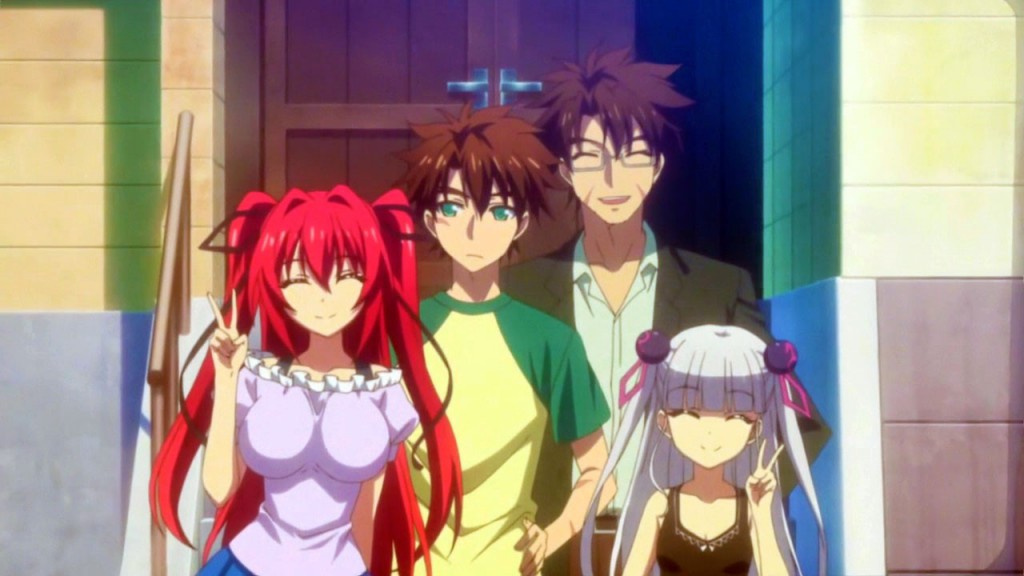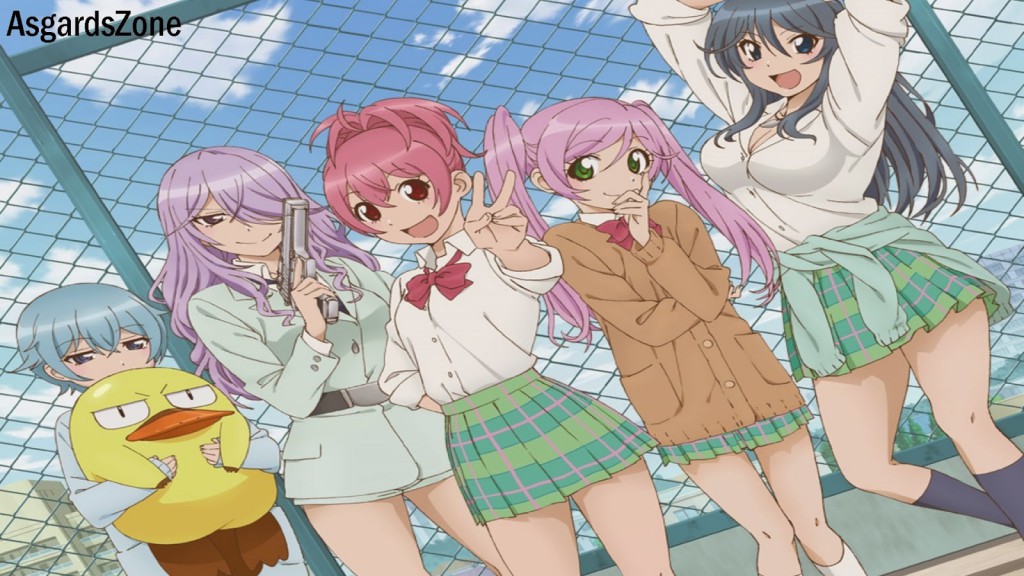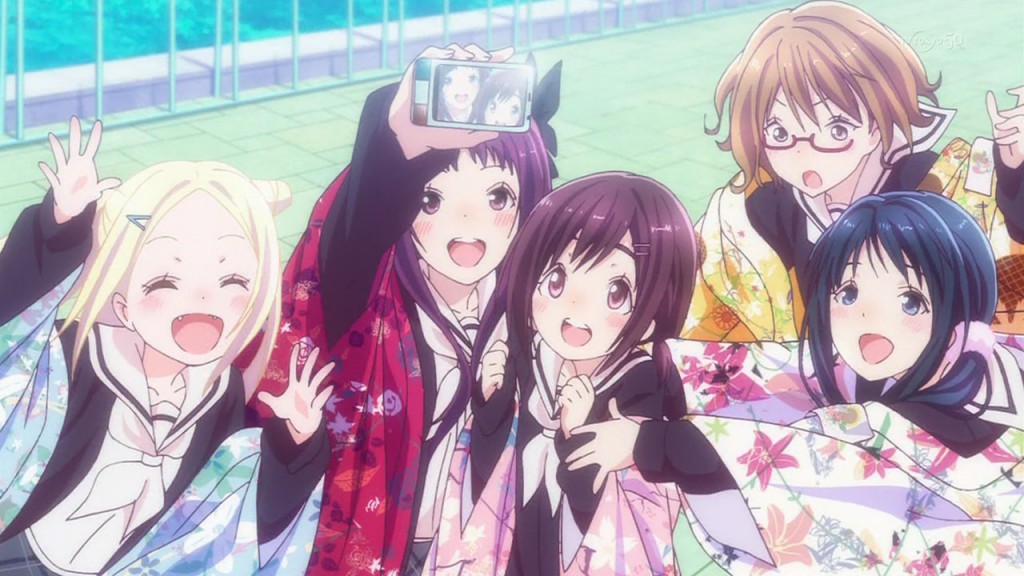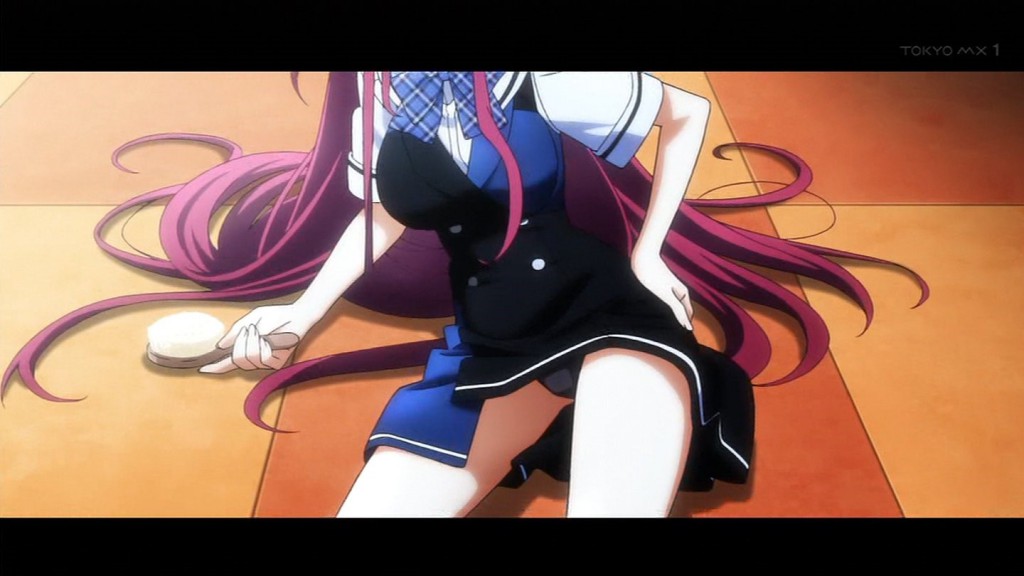September 13th, 2015 in Anime, General Reviews, Shiro Bako OVA by The Droid

“Shiro Bako” (and there is a review out; I do a lot of anime watching and reviewing), was an anime show about making an anime show. The front part of the series spoke about “Exodus!”, which was the first anime they were producing. The OVA is the ‘first episode’ of that anime run, so we can see the fruits of their labors.
The show is about the idol girl group “Tracy”, composed of (left to right) Aya, Akane and either Alpine or Arupin (it depends on which source you use). Their manager also promotes the group Ginger and everything Ginger is, Tracy is not. They perform in front of practically no one and their dressing room is the staff toilet. They are, understandably, depressed and they are on the verge of breaking up when Akane decides to talk to their manager, Taguchi, about things. (more…)
Tags: Adventure, Comedy
September 10th, 2015 in Anime, General Reviews, Movies, The Tale of the Princess Kaguya by The Droid

Another Studio Ghibli release, “The Tale of the Princess Kaguya” (Kaguya-hime no Monogatari) is 95% of a marvelous film. A rather cheap-out ending mars an otherwise magnificent effort, both in story-telling and animation approach.
A bamboo cutter named Sanuki no Miyatsuko lives high in the mountains, plying his trade. One day, while doing his rounds, he discovers a glowing bamboo shoot. Inside is a tiny, tiny girl. Believing her to be a divine presence, Miyatsuko and his wife decide to raise her as their own, calling her “Princess“. The girl grows rapidly and conspicuously, marveling her parents and earning her the nickname “Takenoko” (Little Bamboo) from the other children in the village. Sutemaru, the oldest among Kaguya’s friends, develops a particularly close relationship with her. (more…)
Tags: Fantasy, Historical
September 6th, 2015 in Anime, General Reviews, Tamako Love Movie by The Droid

Why do you have a movie based from a TV series? I find the reason is that you want to wrap things up nicely, you don’t need a full-run season to accomplish that and the movie will allow you to play out the emotional angles better. I can take 70 minutes to really tell my story, rather than having to break in up over three attempts of 24 minutes each. But that doesn’t mean you are guaranteed success and, sadly, the “Tamako Love Movie” fails to deliver.
There is a review out there on the series itself (“Tamako Market”), but the initial skinny is that Tamako Kitashirakawa’s family runs a mochi shop. One day, a bird comes in from a foreign land, helping the prince of his country look for a bride. Tamako was a good candidate, but eventually declined the offer. I assumed the movie was going to look at the aftermath that was caused by these odd people showing up and being a caliber of mooch for four or five months.
The movie starts off on the home island of Prince Mecha Mochimazzi, his sister Choi and the useless bird emissary Dera. They are busy making mochi and wondering aloud how things are going for Tamako and her friends. We then see them and…and…and…for 83 minutes, nothing happens. The main thrust is that Tamako seems adrift, as she does not know what she wants to do with her life. Mochizō Ōji, her rival, her friend and her companion, is planning on going to Tokyo and further his education. It appears she will take over the family business. Oji has to tell her of his decision to leave, but cannot find the gumption to tell her. Tamako decides that she will put forth a great deal of effort with the baton club to be able to participate in a cultural festival and showcase their talents. (more…)
Tags: Comedy, Romance, Slice of Life
September 3rd, 2015 in Anime, General Reviews by The Droid

There are times that you like a caliber of blind-side anime and this one, “The Testament of Sister New Devil”, ( “Shinmai Maō no Tesutamento”) certainly delivers in that category, as it starts off like any other blended family anime.
Basara Tojo (that lost male youth up there) is a first year high school student. He and his father, Jin, live in Tokyo, just the two of them (as mom died a few years earlier). Out of nowhere, Jin announces that he got married, is going on some business and son is to take care of his new step-sisters, Mio (redhead) and Maria (silverhead) Naruse. A bit after they arrive, we discover that they are more than they appear (although a lot was given up during the opening credits). Mio is a Demon princess and heir of the former Demon Lord, Wilbert. (Wilbert? What kind of demon is named ‘Wilbert’? That doesn’t sound too scary to me). Maria is a succubus and is Mio’s follower and guardian. They aren’t true sisters, but emotionally they are.
They actually try to force Basara from his house, using mind control and other demonic curses, but then we learn HIS truth: he was a member of a hero clan (which explains all the scars they have. Like dad and son went to the tattoo parlor to get matching tats?) and wields great powers. Dad and son eventually speak, Dad advises him on the task set before them all and tells them that they are now all family, or at least more than total strangers. (more…)
Tags: Action, Ecchi, Fantasy, Harem, Romance
August 31st, 2015 in Sabagebu! – The Survival Game by The Droid

This is another “Women and Weaponry” submission, potentially closer aligned to “Stella!” and “Girls und Panzer” than “Upotte!” (and I have reviewed all of them, so give them a spin if you haven’t already). For this one, “Sabagebu! – The Survival Game”, it follows a group of high school girls and their daily lives in their survival game club. It all begins with Momoka Sonokawa (Madame Peace Sign), who is a transfer student to a new school. While on the train to school, she is bothered by a pervert when some woman pulls out a pair of side arms to confront the molester, only to get arrested instead. Yeah, it’s usually not a good idea to be yanking guns out to dispense some harsh justice. People freak out, even if they are just airsoft pellet ball weaponry.
Momoka follows this odd lady when she sees her at her school, tracking her over to a run-down building and discovers the Survival Club. The rest of the club are (right to left):
Maya Kyōdō, second-year and gravure idol
Urara Kasugano, first year and a bit of a masochist
Momoka
Miou Ootori, club president and filthy rich (she pulled the guns on the train)
Kayo Gōtokuji, club treasurer and a cosplay freak
Platy, club mascot (more…)
Tags: Action, Comedy, Military, Shoujo
August 27th, 2015 in Anime, General Reviews, Log Horizon second season by The Droid

With the conclusion of the second season of “Log Horizon”, there has to be a third season to wrap it all up, considering the bread crumbs they left. Bread crumbs? More like an entire bakery, but on to the plot.
The first season contended itself with how these people, or ‘adventurers’, trapped inside this video game, can grow an entire civilization. The second season looks at personal growth and it loses a bit of steam on that account. When Shiroe has to contend himself with bureaucracy, wow, the excitement is palpable.
Look! As he signs legislation
Gasp! While he settles land ownership issues
Shiver! When he makes proclamations
OK, I am being snarky, as there are some new issues that arise, but the show feels like it was running in place. The overall concern is that there is something going wrong with the server or the AI or general gameplay, as things are going wrong. Shiroe has to go on raiding parties to try and figure out how to get more funding for the projects he has in mind. Thant means he is away and someone else is in charge. Then when a crisis arises, Enheart Nelreth comes into the city and starts killing people, those left behind seem unable to handle the situation properly. They have to wait for Shiroe’s return to finish the task. (more…)
Tags: Action, Adventure, Fantasy, Game, Magic, Shounen
August 23rd, 2015 in Anime, General Reviews, Hanayamata by The Droid

This was a different show for me. Yes, it is a dancing show, and, on a nuts-and-bolts level, not much different than “AKB0048” or “Long Live!”, in that a group of girls wish to perform, but it is done in a different manner and it is earnest without being overweening. “Hanayamata” tells the story of Naru Sekiya (front and center), an ordinary 14-year old girl who likes fairy tales. She sometimes wishes her life could be like one, but, that’s the harsh realities of real life. You have to play the cards you are dealt. She is worried about her lack of other interests and dearth of friends. She has a nighttime chance encounter with a “fairy”, a foreign girl practicing dance at a temple. On the spur of the moment, Naru asks to join her and she is introduced to the world of yosakoi dancing. And the rest of the team include, left to right:
Hana N. Fountainstand, that foreign girl ‘fairy’
Yaya Sasame, one of Naru’s friends
Machi Tokiwa, student council president
Tami Nishimikado, student council vice-president
Not pictured is Sari Tokiwa, Machi’s sister, a teacher at the school as well as the club advisor and Masaru Ōfuna, the owner of a yosakoi shop. The series is how these girls interact together and push forward in trying to get to a competitive level to be in the Hanairo Festival, where you showcase your skills. Yes, this is a standard show about (a) overcoming adversity, (b) bettering yourself, both physically and emotionally, (c) understanding the power and strength of friendship, (d) taking responsibility for all that you do and don’t do and (e) enjoying life as it is set before you. (more…)
Tags: Comedy, School, Seinen, Slice of Life
August 20th, 2015 in Anime, General Reviews, Hyakka Ryouran: Samurai Bride OVA by The Droid

“Hyakka Ryouran: Samurai Bride” has presented to us a two-episode OVA in which the ladies are, again, challenged in their abilities to be good samurai warriors. This time, the threat comes from a longbow warrior, Uesugi Kagekatsu, potentially more powerful than they are, and the prize is to become the actual bride of Yagyū Munenori, who is the leader of this tiny clan. To do this, they engage in, not martial arts, but homemaking arts, as they show off their ability to cook and clean and be domesticated.
Well, since this is served up with huge doses of silliness, the normal things go wrong, in that the food is either destroyed, completely inedible or made with some weird ingredients. And where would an OVA be without some (huge) degree of flirty behavior and wardrobe malfunctions and all-American nakedness (OK, this this case, all-Japanese nakedness). (more…)
Tags: Action, Comedy, Ecchi, Harem, Samurai, School
August 16th, 2015 in Anime, Chaika the Coffin Princess OVA, General Reviews by The Droid

So, with the conclusion of the second (and potentially, final) season of “Chaika, the Coffin Princess”, it is now time to trot out the OVA, so we can tell a story that otherwise would not have fit into the full run of things. The OVA is actually two half-episodes, where the Red Squad and the White Squad come into contact with one another while avoiding the Kliemann Agency (more or less), but this is done more to be goofy than any real import, much like “Darker Than Black” Episode #26, which was goofy and silly and funny and completely out of character with the show’s original dark and dismal run.
In this outing, the guys and gals are still looking for the parts of dismembered Daddy and come to a location to hunt them down, not knowing the other team is there. The tone here is far lighter, as they have to work together to escape the situation they are in, but it is not done as dramatic or intense as seen in the series; more like a minor inconvenience or annoyance, like bees living in your head. And when Akari has to flatten David twice for doing the same perceived pervy thing twice, well, it’s all for giggles and laughs. (more…)
Tags: Action, Adventure, Comedy, Fantasy, Romance, Shounen
August 9th, 2015 in Anime, General Reviews, The Fruit of Grisaia OVA by The Droid

The OVA for “The Fruit of Grisaia” (or “The Gray-Colored Fruit”) is designed to keep you interested in the show, as a movie (in theory) comes out in April and a new series follows shortly thereafter, but they come off as more unrestricted ecchi. All of the ladies seem to want to do the Wild Thing with Yūji Kazami, but it is done more for our benefit as the viewer than for anything that Yuri might want, or that the ladies are seeking.
I do not need to see a woman, dressed as a Playboy Bunny, riding a giant carrot like Slim Pickens did with that nuke in “Dr. Strangelove” or some girl who gives Yuri a real scrub down in the bath, washing everything including his shower nozzle. No, that’s not a euphemism; she really washes down the shower nozzle. Look, it just might be better for you to watch the shows (they run about six or so minutes each) to understand why they do what they do, as it does not make a lick of real sense, either as an OVA or in the general run of the show. And to make matters worse, it comes off as a painful obligation to do these histrionics, rather than a blossoming girl, experiencing the pangs of first love and true romance and….oh, just take off your clothes. Or, as seen above, a tantalizing glimpse of panties. (more…)
Tags: Drama, Harem, Psychological, Romance, School









